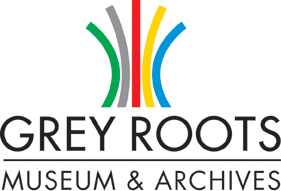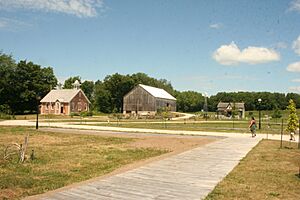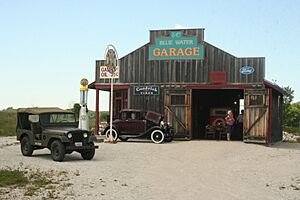Grey Roots Museum and Archives facts for kids
 |
|
 |
|
| Established | 1955 |
|---|---|
| Location | Georgian Bluffs, Ontario |
| Type | County Museum and County Archives |
Grey Roots Museum and Archives is a special place that tells the story of Grey County, Ontario. It started as a small museum in 1955 and has grown into a major center for history and heritage.
Located near Owen Sound, the modern Grey Roots building opened in 2004. It's home to the county's museum, its official records (the archives), and tourist information. Right next door is the Moreston Heritage Village, a cool outdoor area where you can step back in time and see what life was like in Grey County from the 1850s to the 1920s.
Contents
The Story of Grey Roots
The idea for the museum began in 1955 with a few temporary exhibits. By 1959, it became a permanent museum. Over the years, it grew and even added its own heritage village.
In 2000, the Grey County Archives was created to store important historical documents. Soon, both the museum and the archives needed more room. A new property was found, and in 2004, the brand-new Grey Roots building opened for both. Six of the historic buildings from the old village were carefully moved to the new site, with plans to add even more.
What Does the Logo Mean?
The Grey Roots logo looks like a bundle of wheat, called a sheaf. Each color in the logo stands for something important in Grey County.
- Green: The shape of a tree, representing the county's forests.
- Grey: The shape of a rock wall, for the famous escarpment.
- Red: A burst of fireworks, celebrating the people and community.
- Yellow: A stalk of grain, for the county's history of farming.
- Blue: The flow of water, for Grey County's many beautiful waterfalls.
The Museum Building and Village
The main Grey Roots building was designed to connect with nature. It was built using materials that were important to Grey County's growth, like stone, maple wood, and cedar. The outside is made of limestone, and the entrance has a large wooden frame that looks like a classic Grey County barn. There's even a small waterfall inside!
Moreston Heritage Village
Next to the museum is the Moreston Heritage Village, which is like a time machine. It shows life from the 1850s to the 1920s. You can explore buildings like:
- An 1850s Log Cabin and Blacksmith Shop
- An 1880s Log House
- A 1920s Farmhouse and Garage
- A Schoolhouse and a Bandstand
The village is named after the More family, who generously donated the land. It's open during the summer and for special events and school trips throughout the year.
What's in the Collection?
Since 1955, the museum has collected thousands of items, called artifacts, that tell the story of Grey County. These items range from ancient tools used by the first people to things from today.
Each artifact is carefully recorded, photographed, and stored safely. Like most museums, only a small part of the collection is on display at one time. Many of the items can be seen inside the buildings at Moreston Heritage Village.
The museum collects items related to big themes, such as:
- First Nations History
- Pioneer and Settler Life
- Farming and Agriculture
- Military History
- Famous People from Grey County
The museum also has a special "hands-on" collection of items that can be used for school programs, letting you touch a piece of history!
Exhibits and Famous Faces
Grey Roots has many exciting exhibits. The Grey County Gallery tells the main story of the area. There are also large traveling exhibits that change regularly.
One popular exhibit showcases local heroes from Grey County, including:
- Billy Bishop: A famous flying ace from World War I.
- Tom Thomson: A well-known Canadian painter.
- Agnes Macphail: The first woman ever elected to the Canadian Parliament.
You can also explore virtual exhibits on the Grey Roots website, covering topics from local history to Black History in the region.
Museum Partners
Grey Roots works with other major organizations to share and preserve history. These include:
- Canadian Museums Association (CMA)
- Canadian Heritage Information Network (CHIN)
- Virtual Museum of Canada


